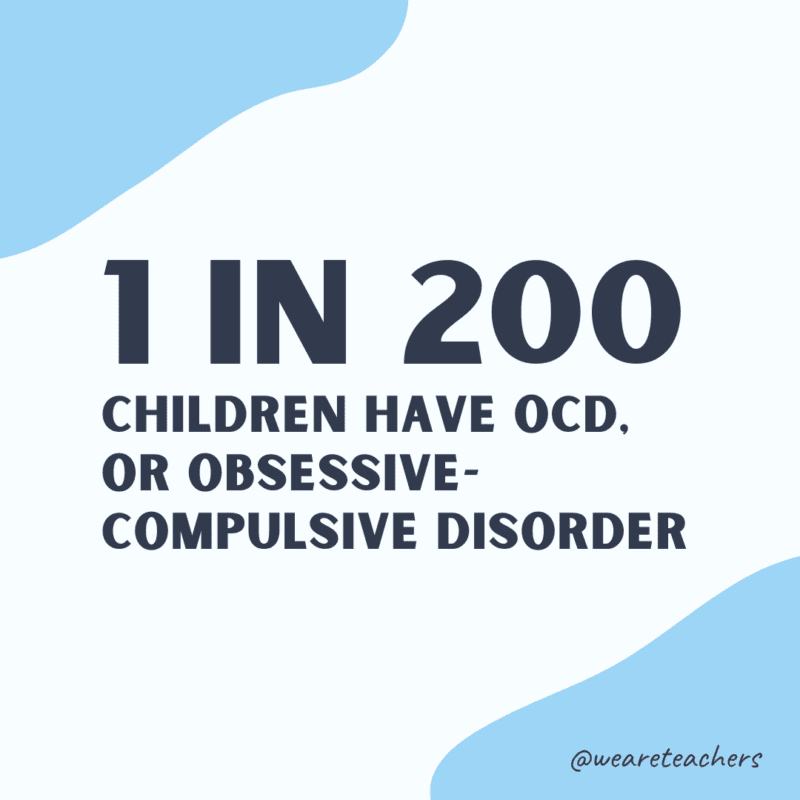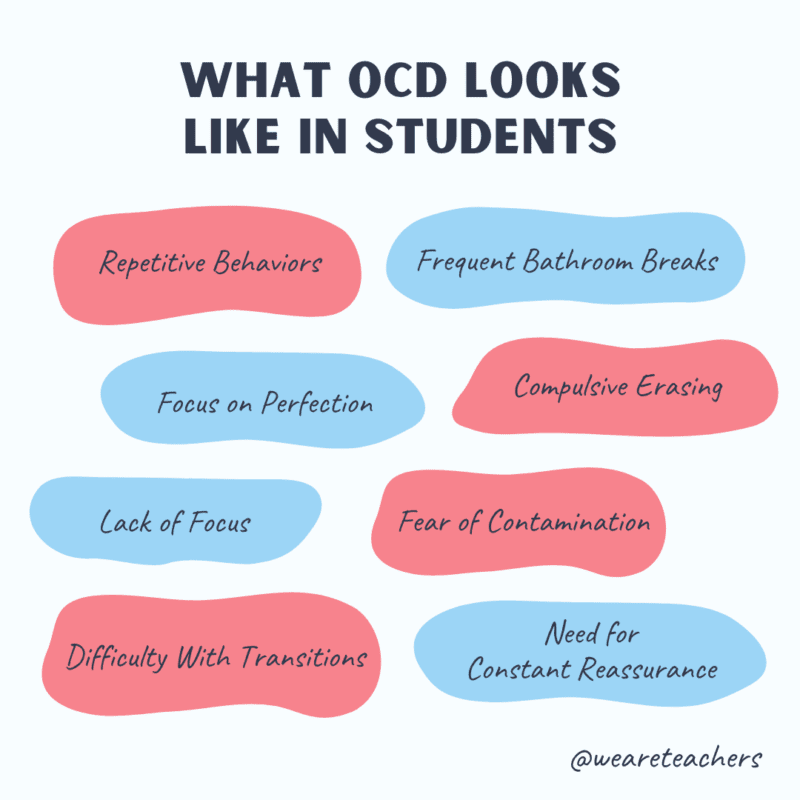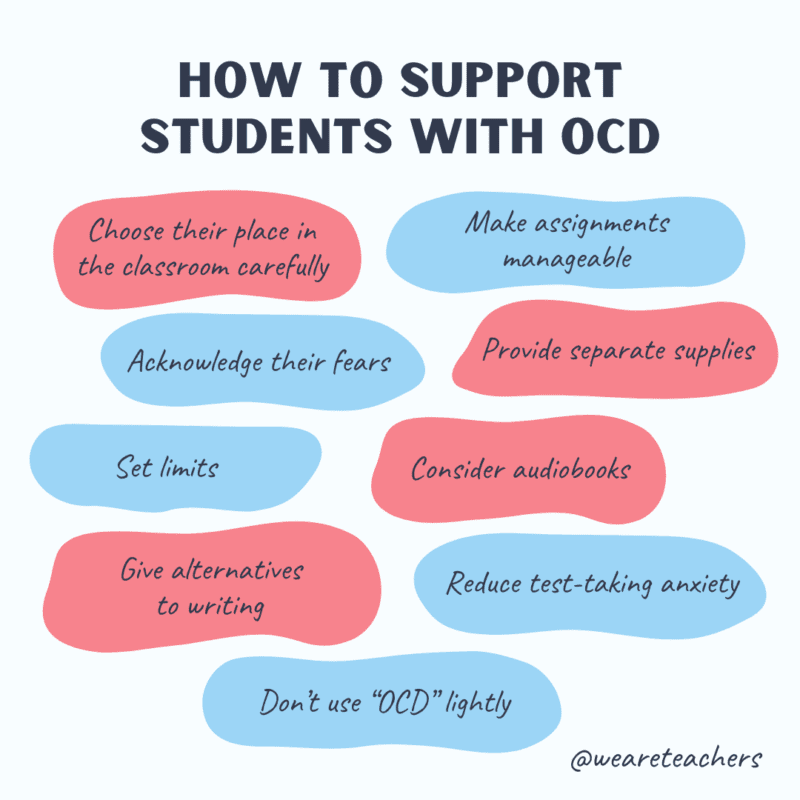What comes to mind when you hear OCD? Do you picture TV detective Adrian Monk refusing to touch door handles because of germs? Or maybe super-nerd Sheldon Cooper, who absolutely has to use the bathroom at the same time each day? These characters often get played for laughs, but living with Obsessive-Compulsive Disorder, often called OCD, is no joke. The obsessions these people experience, and the compulsions they develop to deal with them, can keep them from leading satisfying lives. Students with OCD often struggle academically and socially. Here’s how teachers can help.
What is OCD?
According to Child Mind, OCD is an anxiety condition that plagues a person with unwanted thoughts, images, or impulses called obsessions. The International OCD Foundation estimates that as many as 1 in 200 children have OCD. In an average elementary school, there are at least four or five kids with OCD and as many as 20 in a high school.

People with OCD have unreasonable fears that disrupt their daily lives. They might worry about contamination or fear that they’ll suddenly become violent and hurt themselves or others. To cope with these anxieties, they develop repetitive and ritualized actions. These could include counting, locking and re-locking doors, lining up objects, hand-washing, or skin-picking. Those with OCD can get so involved in those behaviors that they’re unable to focus on other tasks or function normally.
Children as young as five can develop OCD. It’s most commonly diagnosed between the ages of 10 and 12 or between the late teens and early adulthood. To be diagnosed, someone must experience both obsessions and compulsions so strong that they disrupt normal life.
[contextly_auto_sidebar]
What does OCD look like in students?
For students with OCD, school can be a challenging and stressful place. They may appear to be daydreaming, distracted, uninterested, or lazy. In reality, they’re hyper-focused on nagging urges and obsessive thoughts. Here’s what that might look like specifically in your classroom. (See a complete list here.)
Repetitive behaviors
This is one of the classic OCD behaviors. Those with OCD believe their behaviors are absolutely essential to their safety or the safety of others. They might believe that if they don’t line up their pencils from smallest to largest, something terrible will happen to all their friends. They develop rituals like checking locks multiple times or reading a paragraph three times out loud before going on to the next one.
If a student with OCD has a bad thought when going through a door, for example, they may want to go back and “fix it.” They will retrace steps and attempt to right the wrong of a bad thought or an item left in a room. Attempting to disrupt or deny these behaviors can lead to complete meltdowns.
Frequent bathroom breaks
The bathroom is a safe space for lots of students. Those with OCD may go there to be alone with their anxieties. If they have fears of contamination, they might be washing their hands or even school supplies obsessively. They might also retreat there to perform repetitive behaviors like skin-picking.
Focus on perfection
There’s a difference between wanting to do your best and never feeling something is good enough. Students with OCD often focus on perfection. This leads them to spend an excessive amount of time on assignments and especially tests. They may also resist leaving a task unfinished and moving on to something else.
Compulsive erasing
Given that need for perfection, students with OCD especially struggle with writing. They may write and re-write something over and over, erasing it until there are holes in the page. Or, a minor error may cause them to scribble all over the page, trying to make the problem disappear.
Lack of focus
There are many reasons students can appear distracted. But those with OCD are usually dealing with intrusive and obsessive thoughts. For instance, they may be counting the number of red objects in the room, and fear if they miss one, a family member could die. Not surprisingly, those sorts of thoughts make it very hard to concentrate on schoolwork.
Fear of contamination
Many people with OCD have a severe fear of germs and dirt. This leads to compulsive hand-washing (sometimes to the point that their hands bleed). It also means kids might avoid doing things like sitting on the floor, touching books in the library, or even joining in on a messy art project.
Difficulty with transitions
For many kids, moving from one subject or class to the next is as easy as scooping up their stuff and moving on. For kids with OCD, it’s not that simple. Their items may need to be arranged just so. They might not want to leave unfinished work behind. And when they start the next subject or class, everything has to be arranged exactly right all over again.
Need for constant reassurance
To quell their anxieties, students with OCD seek constant assurance that everything is okay. They might ask the same question about how to complete an assignment over and over again, interrupting the teacher when everyone else has moved on. They’ll straighten their books, check their backpack again and again to make sure everything is there, or apologize profusely for breaking a very small rule.

How can teachers support students with OCD?
Understanding OCD and its behaviors is a good first step. Students who are diagnosed with OCD often undergo cognitive behavioral therapy (CBT). An IEP/504 plan developed with their therapist may outline specific actions for schools and teachers to take.
Tip: Remember, accommodations aren’t treatment. Sometimes you may be asked to do something that seems to be allowing behavior that you feel ought to be stopped. But that’s up to a student and their doctor or therapist. As a teacher, you want to focus on how they can succeed in your classroom. Some of these actions might help. (See more ideas here.)
Choose their place in the classroom carefully
Finding the right place for a student with OCD can be tricky. They might need to sit facing away from an object that causes obsessive thoughts. Eliminating distractions like noise or movement might help. Many students need a safe space to fidget, rock, or perform another calming behavior (unless they’re actively working to overcome that action).
Make assignments manageable
Students with OCD see any assignment as a chance to make endless mistakes, and longer assignments are even worse. Help younger students by breaking assignments into shorter tasks (read just one paragraph or page at a time, or give them just one math problem rather than a whole worksheet). Teach older students to do the same for themselves.
Reduce test-taking anxiety
Tests are enough to raise anxiety in any kid, but they’re a disaster for those seeking perfection. Ensure the test focuses on what you need to assess, and eliminate unnecessary distractions. If a student takes too long to write, let them type their answers. Some students with OCD have trouble with bubble sheets, feeling the need to fill in each circle perfectly. Is there another way to take the test? Can an aide fill in the sheet for them, allowing them to focus on the questions themselves?
Provide separate supplies
For students with fears about germs and contamination, shared supplies are a nightmare. Even when schools make special efforts to keep things clean, a person with OCD may not trust or believe. Give them their own set of supplies when possible. Hand them their worksheet first, so they know other students haven’t touched it, and make sure they have books marked for their own particular use.
Give alternatives to writing
When writing isn’t the focus, don’t make it necessary for success. Let them provide information orally or use a computer to type their answers. Whenever possible, don’t grade work on neatness or nitpick about items that don’t apply to the learning at hand. (For instance, don’t correct spelling on a science paper if it really doesn’t make much of a difference.)
Consider audiobooks
When reading proficiency isn’t the goal, audiobooks can be an excellent tool for students with OCD. Reading often takes them longer, as they obsessively go back over a paragraph again and again, so they don’t miss anything. Audiobooks continue on their own, providing information at a more regular pace.
Set limits
Compulsive behaviors can continue on and on. Let a student know that you’ll be limiting what’s acceptable. Do they often disappear to the bathroom to perform a repetitive behavior? Limit their visits to a certain number per day, with a set number of allowed minutes. (Of course, you can make exceptions for illness, etc.) For students who ask questions repeatedly, give them a maximum number of times (say, 3) that you’ll answer. When a student feels the need to check their supplies obsessively or wash their hands again and again, try limiting that to certain times of day. Communicate these limits clearly, and stick to them.
Acknowledge their fears
You might feel the need to attempt to reassure students their fears aren’t really a problem. After all, you know perfectly well that the student won’t get into a car accident on the way home if they accidentally step on a line in the tile floor. But that doesn’t really help students with OCD. It’s okay to acknowledge and validate their feelings, without agreeing that their fears are true. Knowing that you understand and accept them can make a big difference.
Don’t use “OCD” lightly
It’s become common for us to joke about being “so OCD” about something, like wanting desks to be lined up straight or grading with your favorite pen. But OCD is no joke to the people who have it. Consider your words carefully when you speak.

How can I connect with students with OCD?
Kids with OCD want to succeed and can get very frustrated that their own behavior is getting in the way. According to Denise Egan Stack, a behavioral therapist from the International OCD Foundation, building a relationship is the key to a successful learning experience. Some students with OCD seek teachers out for approval and reassurance. Others, though, may hide because they feel ashamed or don’t want to cause trouble. In that case, a teacher may need to be the one to reach out.
Egan Stack notes that these students do well with set check-ins. Set aside time to meet and talk about how things are going. This can help students cross the barrier when they’re tempted to hide and avoid dealing with their OCD. Instead, you can work together to make plans.
Build a team to support the student and make them a part of regular meetings as well. This team could include parents, school counselors, the student’s therapist, and, of course, the student themselves.
OCD Resources for Teachers
The more you understand about OCD, the more you can help and support your students affected by it. Try these resources for more information.
Online
Books
- Students with OCD: A Handbook for School Personnel (Adams, 2011)
- Talking Back to OCD: The Program That Helps Kids and Teens Say “No Way” and Parents Say “Way to Go” (March/Benton, 2006)
- Standing Up to OCD Workbook For Kids (Reuter, 2019)
How do you support students with OCD in your classroom? Come share your thoughts and ask for advice on the WeAreTeachers HELPLINE group on Facebook.
Plus, 10 ways to help students who struggle with anxiety.


